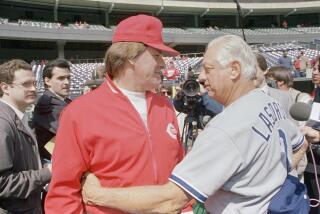Shrine Games
COOPERSTOWN, N.Y. — One of the more ironic exhibits in the National Baseball Hall of Fame and Museum is tucked away behind the Hall of Fame Gallery, up a winding, elevated ramp and past the “scribes and mikemen” display.
It is a plaque commemorating winners of the Lou Gehrig Memorial Award, “presented annually to the Major League Baseball player who both on and off the field best exemplifies the character” of the virtuous New York Yankee great.
There, listed under 1969 on the plaque hanging in this most inconspicuous spot, a hallway leading to men’s and women’s restrooms, is the name of a player whose Hall-worthy efforts on the field have yet to eclipse his dishonorable deeds off of it:
Pete Rose.
To many, Rose essentially flushed away any chance of a Hall of Fame induction in 1989, when he agreed to a lifetime ban from baseball for betting on games when he was manager of the Cincinnati Reds. Baseball’s all-time hit leader has since worked tirelessly to expunge his name from Major League Baseball’s blacklist, to no avail.
But regardless of whether the latest push for Rose’s reinstatement is successful, the Hall is, in many respects, already a shrine to the controversial figure. In fact, the number of Rose references and artifacts rivals those of Hall of Famers Babe Ruth, Hank Aaron, Stan Musial and Ted Williams.
Consider the records room, where Rose dominates the Wrigley Field scoreboard-style placards listing the game’s top hitting marks. He’s first in hits (4,256), games (3,562) and at-bats (14,053), second in doubles (746) and fifth in runs (2,165).
Rose’s most significant accomplishment -- breaking Ty Cobb’s all-time hit record with a first-inning single off San Diego pitcher Eric Show on Sept. 11, 1985 -- is documented nearby in a photographic display of baseball’s 10 most memorable moments, voted on last season by fans.
The exhibits acknowledging Rose’s contributions to the game stretch on throughout the three-story Hall like one of his doubles in a gap.
Purists might argue that displays chronicling the achievements of a banned player amount to baseball blasphemy.
But Dale Petroskey, the Hall’s president, insisted they are a vital part of the game’s history.
“You can’t tell the story of baseball without telling the story of Pete Rose,” Petroskey said. “It is our responsibility to tell the story of the greatest players, the greatest managers, the greatest executives and greatest umpires. Pete Rose is a big part of the history of this game.”
Petroskey stressed that the Hall of Fame and the museum are separate entities. Entry into the Hall of Fame requires election by members of the Baseball Writers’ Assn. of America or Veterans Committee, who must take into account a somewhat ambiguous set of rules. The rules stipulate that “voting shall be based on the player’s record, playing ability, integrity, sportsmanship, character and contributions to the team(s) on which the player played.”
There are no such requirements for players to have their exploits chronicled in the museum.
And Rose is by no means the only banned player whose feats are on display. “Shoeless” Joe Jackson, implicated in the “Black Sox” scandal of 1919, is the subject of several exhibits. Jackson and seven White Sox teammates were accused of accepting money from gamblers in exchange for throwing World Series games. (Curious, as Jackson hit .375 with the Series’ only home run and threw out five runners trying to score.)
Though the White Sox players were acquitted by a jury, Commissioner Kenesaw Mountain Landis suspended them. They are among the 19 on baseball’s list of players ineligible for election into the Hall of Fame.
Several Hall of Famers might have committed more despicable acts than their ineligible brethren. Adrian Constantine “Cap” Anson, a Chicago White Stockings manager, was said to have once forced a team from Newark to bench its black pitcher and catcher before agreeing to play an 1887 exhibition game.
Yet, Anson is recognized as “a hero” in an exhibit recognizing the White Stockings, who captured the initial National League pennant. Anson’s Hall of Fame plaque recalls him as the “greatest hitter and greatest National League player-manager of 19th century.”
Cobb, widely considered a racist, and John McGraw, the early 20th century New York Giant manager who viewed clean play as a sign of weakness, are also held above reproach. Clearly, the exhibits provide a historical perspective free of moral judgment.
“We try not to get into revisionist history,” Petroskey said. “The mores of today are very different than the mores of the turn of the century or the early part of the century. I don’t think any of us are proud of some of the attitudes back then.”
Petroskey makes no apologies for Rose either. But it’s not as if he considers yanking Rose exhibits every time someone raises the betting issue.
A glass-enclosed display honoring Cincinnati’s “Big Red Machine” teams of the 1970s is rife with Rose artifacts. Among them:
* The batting helmet Rose wore during the 1973 season, when he won the batting title and was selected the National League’s most valuable player.
* The bat Rose used to collect his 4,000th hit, on April 13, 1984.
* A photo of Rose sliding headfirst, arms outstretched, into home plate at Wrigley Field.
A tribute with the display reads, “A rose by any other name is still a Rose, particularly if he hustles every second in a dirty uniform.”
More references to Rose can be found in the Hall’s library, which contains photo files, newspaper articles and audio/video clips of every major league player past and present.
Rose goodies might not be for sale at the gift shop, but they are available at many of the memorabilia stores that line Main Street, just a few doors down from the Hall.
Turns out that Rose possesses at least one thing none of the 256 Hall of Famers does: a Cooperstown store named after him. At Pete Rose Ballpark Collectibles, a Wheaties box autographed by Rose goes for $125, while a signed pair of spikes commands $275.
But even here, amid the reverential overload, lies a reminder of Rose’s darker side. In a display case rests a copy of the May 9, 1988 issue of Sports Illustrated, with a picture of Rose and the headline “SUSPENDED!” on the cover. The subhead reads, “Pete Rose gets 30 days for shoving an umpire.”
Pressed for details on Rose’s affiliation with the store, the man behind the counter turned testy and refused to comment.
Across the street at Mickey’s Place, another memorabilia shop, manager Kevin Klix said Rose signs hundreds of autographs at the store every summer during Hall of Fame weekend. Of course, that hasn’t driven down the price of a Rose-autographed baseball ($85) or photo ($60) at Mickey’s.
Funny thing is, perhaps nowhere is Rose more celebrated than the place where he is also banned.
“We give him a lot of recognition in the museum,” Petroskey said. “The only thing missing is a plaque on the wall in the Hall of Fame.”
*
(BEGIN TEXT OF INFOBOX)
19 Men Out
Pete Rose and “Shoeless” Joe Jackson had careers that would have led to their enshrinement in baseball’s Hall of Fame -- had they not been banned along with 17 other players of lesser accomplishments. Eight of the suspended were members of the 1919 Chicago White Sox, who were accused of fixing World Series games. The list:
Eddie Cicotte: Member of the 1919 Chicago White Sox.
William Cox: Former Philadelphia Phillie owner was sanctioned in 1943 for betting on Phillie games.
Cozy Dolan: Former New York Giant coach was accused of trying to fix a game in 1924. Questioned by Commissioner Kenesaw Mountain Landis, his answers were considered evasive.
Phil Douglas: He wrote a former teammate opaquely offering to desert the New York Giants, if rewarded, so he would not have to help Manager John McGraw, whom he hated, win a pennant. His career ended in 1922.
Jean Dubuc: National League pitcher was involved with Heinie Zimmerman in 1919 World Series fix.
Happy Felsch: Member of the 1919 Chicago White Sox.
Ray Fisher: A respected gentleman and longtime baseball coach at the University of Michigan, he was sanctioned in 1921 for contract jumping.
Chick Gandil: Member of the 1919 Chicago White Sox.
Joe Gedeon: Former St. Louis second baseman served on the ad hoc committee to throw the 1919 World Series.
“Shoeless” Joe Jackson: Member of the 1919 Chicago White Sox.
Lee Magee: He confessed to helping fix games in 1918. Said if he was barred he would take some famous people with him “for tricks turned ever since 1906.”
Fred McMullin: Member of the 1919 Chicago White Sox.
Jimmy O’Connell: New York Giant player told Philadelphia infielder Heinie Sand before a game in 1924 that “it will be worth $500 to you if you don’t bear down on us today.” On whose authority he acted was never ascertained.
Gene Paulette: Philadelphia Phillie first baseman accepted gifts from a St. Louis gambler in 1919.
Swede Risberg: Member of the 1919 Chicago White Sox.
Pete Rose: Cincinnati Red player and manager in 1989 accepted lifetime ban for gambling activities.
Buck Weaver: Member of the 1919 Chicago White Sox.
Lefty Williams: Member of the 1919 Chicago White Sox.
Heinie Zimmerman: Batting and home run champion for the 1912 Chicago Cubs allegedly tried to bribe several players to fix games.
*
Source: Major League Baseball
More to Read
Go beyond the scoreboard
Get the latest on L.A.'s teams in the daily Sports Report newsletter.
You may occasionally receive promotional content from the Los Angeles Times.











